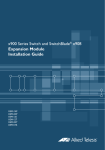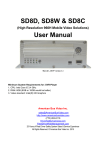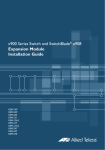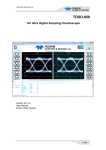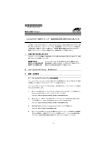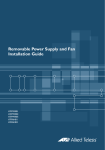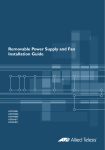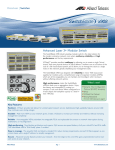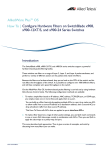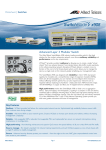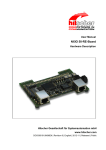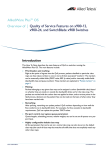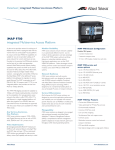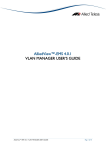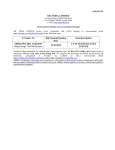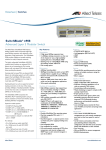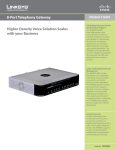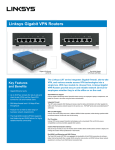Download Allied Telesis AlliedWare Plus 5.2.1 User's Manual
Transcript
Datasheet | Operating System AlliedWare PlusTM 5.2.1 Operating System AlliedWare PlusTM Layer 3 Fully Featured Operating System AlliedWare Plus™ is Allied Telesis' next generation operating system. In keeping with the increasing complexity of Allied Telesis' ever-improving and feature-rich software, AlliedWare Plus employs a new modular approach to software creation and distribution. It represents a quantum shift in the software development methodology for Allied Telesis switches and routers - providing you with even more features and greater robustness from the operating system. The AlliedWare Plus operating system combines superior networking functionality and strong management capabilities with the exceptional performance that today's networks demand. A standards-based implementation, it also assures full interoperability with other major network equipment, along with improved usability and therefore a superior customer experience. High-Performance and High-Availability Virtual Chassis Stacking Virtual Chassis Stacking makes networking simple. It allows you to connect between 2 and 81 switches together via high-bandwidth 15Gbps stacking links.This aggregates the switches, which then appear as a single switch, or 'Virtual Chassis'. The Virtual Chassis can be configured and managed via a single serial console or IP address, which provides greater ease of management in comparison to an arrangement of individually managed switches, and often eliminates the need to configure protocols like VRRP and Spanning Tree. Virtual Chassis Stacking provides a high availability system where network resources can be spread out across a number of stacked switches, thus reducing the impact should any one of the stacked switches fail. Ports on different switches across the stack can be aggregated to provide excellent link redundancy. Allied Telesis AlliedWare Plus TM O P E R AT I N G S YS T E M Hot-swappable XEM modules The AlliedWare Plus operating system supports hot-swappable XEM modules, dramatically reducing system downtime.You can remove and add XEM modules, or swap a XEM for another of the same sort - all without having to reboot or reconfigure your network. AlliedWare Plus Advanced Features Modularity + Monitoring = Robust Flexibility • Bridge Protocol Data Unit (BPDU) Protection AlliedWare Plus has a modular architecture, providing superior reliability. It uses separate software processes, or modules, to handle different functions - for example management, routing protocols, and control functions. Each of these modules can only access its own allocated memory, which prevents processes from corrupting each other and causing system crashes. Although independent of each other, modules communicate via well-defined interfaces. • Control Plane Prioritization - CPP To achieve even greater reliability, independent monitoring software has been utilized alongside the modular architecture.This provides passive monitoring and periodic health checks for all important processes, and sends messages to inform system administrators of issues and resolutions. • Industry Standard Command Line Interface • Virtual Chassis Stacking • Highly Modular Software Featuring Independent Process Monitoring • Superior Quality of Service - QoS • 802.1x Dynamic VLANs Other Feature Highlights • Access Control Lists - ACLs • Spanning Tree • Ethernet Protected Switching Rings - EPSR • Virtual Router Redundancy Protocol - VRRP • Link Aggregation Control Protocol - LACP • Trigger Facility • Logging Facility • Scripting • Web (HTTP) client • Simple Mail Transfer Protocol - SMTP • Trivial File Transfer Protocol - TFTP Client • Dynamic Host Configuration Protocol Server and Client - DHCP Industry Standard Command Line Interface (CLI) The AlliedWare Plus operating system incorporates an industry standard CLI, facilitating intuitive manageability. Each command is associated with a specific function, or a common function performing a specific task.You can automate some of your configuration tasks, as many of these commands may also be used in scripts.Triggers can also be utilized, providing a powerful mechanism for automatic and timed management by automating the execution of commands in response to specific events. • Simple Network Management Protocol SNMP • Internet Group Management Protocol - IGMP • IPv4 and IPv6 Static Routing • Routing Information Protocol - RIP • Open Shortest Path First - OSPF 1 AlliedWare Plus software release 5.2.1 supports stacking of 2 units. Support for more than 2 units will be available in a future release. Continued on next page. www.alliedtelesis.com AlliedWare PlusTM | Operating System Continued from previous page. Resiliency Security With three distinct modes, the CLI is very secure. User exec mode allows users to view settings and troubleshoot problems but does not allow any changes to be made to the system. Privileged execmode allows users to change system settings and restart the device. Configuration changes are only permitted in global configuration mode, which reduces the risk of making accidental configuration changes. Link Aggregation Link aggregation allows a number of individual switch ports to be combined, forming a single logical connection of higher bandwidth.This provides a higher performance link, and also provides redundancy for a more reliable and robust network. 802.1x, RADIUS Authentication and Dynamic VLAN Assignment The IEEE 802.1x standard manages port-based network access. It provides authentication to devices attached to a LAN port by initiating a connection or preventing access from that port if authentication fails. Valuable for authenticating and controlling user traffic to a protected network, 802.1x is also effective for dynamically varying encryption keys. 802.1x attaches the Extensible Authentication Protocol (EAP) to both wired and wireless LAN media, and supports multiple authentication methods, such as token cards, Kerberos, certificates, and public key authentication. AlliedWare Plus Licensing Unlocks New Features With AlliedWare Plus, a single license password or 'key' is all that is necessary to activate a feature bundle.This single key enables the bundled features on all hardware of that particular product type. License keys enable you to "unlock" additional feature bundles that ship with the switches. Policy-Based Quality of Service (QoS) Comprehensive, low latency QoS features operating at wire-speed provide flow-based traffic management with full classification, prioritization, traffic shaping and min/max bandwidth profiles. The QoS features are ideal for service providers wanting to ensure maximum availability of premium voice, video and data services, and at the same time manage customer service level agreements. For enterprise customers, the QoS features protect productivity by guaranteeing performance of business-critical applications (including VoIP services), and help to restore and maintain responsiveness of enterprise applications in the workplace. Control Plane Prioritization The Control Plane Prioritization (CPP) feature allows you to allocate priorities to packet types, to ensure minimum interruption to the flow of control information through the network. CPP stops the control plane from being flooded by traffic in the event of a network storm or Denial of Service (DoS) attack.This ensures maximal performance and prevents network outages. In addition, with CPP you can also limit the amount of traffic that flows to the CPU to ensure that performance of other services, such as the CLI, are not affected should a network storm or DoS attack occur. Allied Telesis AlliedWare Plus supports IEEE standard 802.3ad link aggregation, which can be configured manually, or automated via the use of Link Aggregation Control Protocol (LACP). LACP automatically detects multiple links between two LACP enabled devices and configures them to use their maximum possible bandwidth by automatically combining the links. VRRP - Virtual Router Redundancy Protocol VRRP provides automatic backup in mission-critical environments.This feature enables multiple routers or switches to share a virtual IP address that serves as the default LAN gateway. Should the master fail, the other devices assume the virtual IP address. LAN devices can continue to be configured with a single default gateway address, and because VRRP is a standards based protocol, full interoperability with other VRRP-supported products is assured. Ethernet Protection Switching Ring (EPSR) EPSR allows several switches to form a protected ring with sub 50ms failover.This feature is perfect for high performance at the core of enterprise or provider access networks. MSTP - Multiple Spanning Tree Protocol MSTP addresses the limitations in the existing spanning tree protocols, Spanning Tree Protocol (STP) and Rapid Spanning Tree Protocol (RSTP). MSTP is similar to RSTP in that it provides loop resolution and rapid convergence. However it also has the significant extra advantage of making it possible to have different forwarding paths for different multiple spanning tree instances.This enables load balancing of network traffic across redundant links. Dual Software Images Dual software images can be stored, providing separate primary and secondary operating system files that function as backup during upgrades. 802.1x uses the RADIUS (Remote Authentication Dial In User Service) protocol to transfer authentication and configuration information between the switch and a shared RADIUS authentication Server., which manages a database of users and provides authentication and configuration information to the client. Dynamic VLAN assignment allows an 802.1x supplicant to be placed into a specific VLAN based on information returned from the RADIUS server during authentication.This limits the network access of a supplicant to a specific VLAN that is tied to their authentication, and prevents supplicants from connecting to VLANs for which they are not authorized. A port's VLAN assignment is determined by the first supplicant to be authenticated on the port. SSHv2 and SCP The Secure Shell (SSH) version 2 protocol provides encrypted and strongly authenticated remote login sessions. SSHv2 provides sessions between a host running a Secure Shell server and a machine with a Secure Shell client. Secure Copy Protocol (SCP) is also supported. SCP allows for secure file transfer to and from the switch, protecting your network from unwanted downloads and unauthorized file copying. Access Control Lists (ACLs) AlliedWare Plus delivers industry-standard Access Control functionality through access control lists (ACLs). ACLs filter network traffic to control whether routed packets are forwarded or blocked at the port interface.The switch examines each packet to determine whether to forward or drop the packet based on the criteria that is specified within the ACL, such as source and destination MAC or IP address, IP protocol, or TCP/UDP port. This provides a powerful network security mechanism to select the types of traffic to be analyzed, forwarded, or influenced in some way, for example to restrict routing updates or provide traffic flow control. www.alliedtelesis.com AlliedWare PlusTM | Operating System Bridge Protocol Data Unit (BPDU) Protection BPDU Protection adds extra security to the Spanning Tree Protocol (STP). It protects the spanning tree configuration by preventing malicious DoS attacks caused by spoofed BPDUs. BPDU Protection is designed to be enabled on ports that should not receive BPDUs.These are edge ports connected to end user devices that do not run spanning tree. If a spoofed BPDU packet is received on a protected port, the BPDU Protection feature disables the port and alerts the network manager. Allied Telesis VLAN Double Tagging VLAN double tagging allows network service providers to use a single VLAN to support customers with multiple VLANs. In this way, they can simply and cost-effectively offer IP-based solutions in scalable implementations. Service providers often have customers whose VLAN range requirements overlap, and the traffic from different customers is mixed in with the service providers' infrastructure. With VLAN double tagging, each customer is given a customer-ID (CID), which is a unique identifier within the service provider infrastructure.Traffic from individual customers is tagged with the CID and segregated from other customer's traffic.The VLANs identification of the customer's network can be preserved while the traffic is tunnelled through the network service provider's infrastructure. www.alliedtelesis.com AlliedWare PlusTM | Operating System AlliedWare Plus Operating System Features Allied Telesis Product Software Release Switching Bridging (IEEE 802.1D) VLAN - Virtual Local Area Network Storm Protection Jumbo Frames VLAN Double Tagging (Q-in-Q) High Availability STP - Spanning Tree Protocol RSTP - Rapid Spanning Tree Protocol MSTP (802.1s) - Multiple Spanning Tree Protocol EPSR - Ethernet Protected Switched Rings VRRP - Virtual Router Redundancy Protocol LACP - Link Aggregation Control Protocol (802.3ad) Virtual Chassis Stacking Security 802.1x 802.1x VLAN Assignment Access Control Lists SSL - Secure Sockets Layer SSHv2 - Secure Shell version 2 RADIUS BPDU Protection Intrusion Detection (Port Security) Private VLANs DHCP Option 82 QoS / Performance Tuning QoS - Quality of Service Policy Based QoS Strict Priority and/or WRR Queue Servicing - Weighted Round Robin WRED Curves - Weighted Random Early Discard Priority Tagging (IEEE 802.1p) Single-Rate Three-Color Marking Two-Rate Three-Color Marking Network Manageability CLI - Command Line Interface RMON (1,2,3,9) HTTP Client TFTP Client - Trivial File Transfer Protocol SNMP - Simple Network Management Protocol Trigger Facility Test Facility Scripting SCP - Secure Copy DHCP Client and Server- Dynamic Host Configuration Protocol Text Editor Telnet NTP - Network Time Protocol Ping Polling Syslog DHCP Relay DNS Relay - Domain Name System Routing OSPFv2 - Open Shortest Path First BGP-4 - Border Gateway Protocol version 4 RIPv1, RIPv2 ECMP - Equal Cost Multipath Protocol Route Maps IPv6 Static Routes RIPng Multicasting IGMP - Internet Group Management Protocol IGMP Proxy PIM-SM - Protocol Independent Multicast Sparse Mode Allied Telesis x900-12X x900-24X AT-SBx908 5.2.1 5.2.1 5.2.1 D D D D D D D D D D D D AL3 AL3 AL3 D D D D D D D D D D D D D D F D D D D D D D D D D D D D D D D D D D D D D D D D D D D D D D D D D D D D D D D D D D D D D D D D D D D D D D D D D D D D D D D D D D D D D D D D D D D D D D D D D D D D D D D D D D D D D D D D D D D D D D D D D D D AL3 AL3 AL3 AL3 AL3 AL3 D D D D D D D D D IPv6 IPv6 IPv6 IPv6 IPv6 IPv6 D D D D D D AL3 AL3 AL3 D = Feature is available in the Standard AlliedWare release of this product AL3 = Feature is available with the Advanced L3 feature license for this product F = Feature will be available in a future release IPv6 =Feature is available with the Advanced IPv6 feature license for this product Note: This table does not provide a complete AlliedWare Plus® feature list. For more information about individual products, see www.alliedtelesis.com. www.alliedtelesis.com AlliedWare PlusTM | Operating System Feature licenses Product Advanced L3: BGP-4 OSPF PIMv4 VLAN Double Tagging IPv6 Pack2: IPv6 Static Routing IPv6 Management RIPng SwitchBlade® x908 AT-FL-SBX9-01 AT-FL-SBX9-01 Order number 980-000130 980-000130 x900-24XT AT-FL-X900-01 AT-FL-X900-02 Order number 980-000127 980-000128 x900-24XT-N AT-FL-X900-01 AT-FL-X900-02 Order number 980-000127 980-000128 x900-24XS AT-FL-X900-01 AT-FL-X900-02 Order number 980-000127 980-000128 x900-12XT/S AT-FL-X900-01 AT-FL-X900-02 Order number 980-000127 980-000128 About Allied Telesis Service and Support Allied Telesis is part of the Allied Telesis Group. Founded in 1987, the company is a global provider of secure Ethernet/IP access solutions and an industry leader in the deployment of IP Triple Play networks over copper and fiber access infrastructure. Our POTS-to-10G iMAP integrated Multiservice Access Platform and iMG intelligent Multiservice Gateways, in conjunction with advanced switching, routing and WDM-based transport solutions, enable public and private network operators and service providers of all sizes to deploy scalable, carriergrade networks for the cost-effective delivery of packet-based voice, video and data services.Visit us online at www.alliedtelesis.com. Allied Telesis provides value-added support services for its customers under its Net.Cover programs. For more information on Net.Cover support programs available in your area, contact your Allied Telesis sales representative or visit our website: www.alliedtelesis.com. 2 Available late 2008 USA Headquarters | 19800 North Creek Parkway | Suite 100 | Bothell | WA 98011 | USA | T: +1 800 424 4284 | F: +1 425 481 3895 European Headquarters | Via Motta 24 | 6830 Chiasso | Switzerland | T: +41 91 69769.00 | F: +41 91 69769.11 Asia-Pacific Headquarters | 11 Tai Seng Link | Singapore | 534182 | T: +65 6383 3832 | F: +65 6383 3830 www.alliedtelesis.com © 2008 Allied Telesis Inc. All rights reserved. Information in this document is subject to change without notice. All company names, logos, and product designs that are trademarks or registered trademarks are the property of their respective owners. 617-000477 Rev. D







